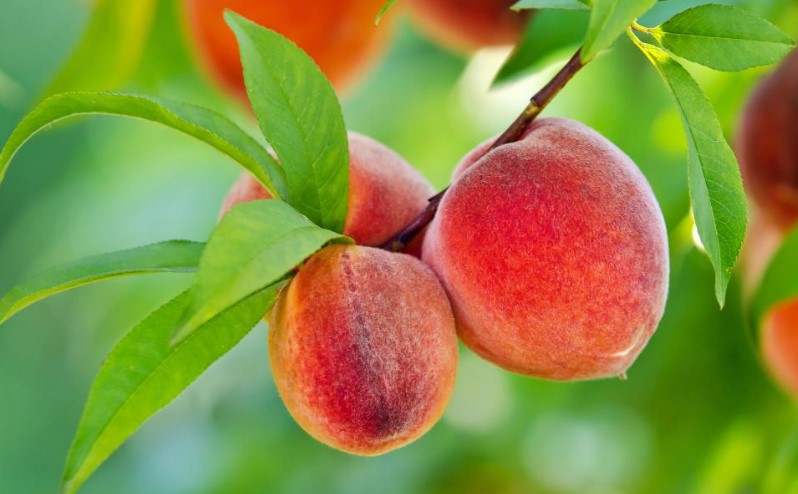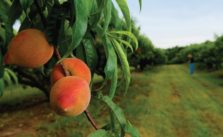If you should be growing peach trees, you realize they need a great deal of sunshine. In reality, they flourish within an area where they are able to take in the sunshine through the whole-day. Peach trees’ treatment isn’t too difficult. They don’t demand much publicity and muss. Keep reading for more information about peachtree care.
How to Grow Peaches?

The apple is just a semi- hardy deciduous woody evergreen tree. A standard- sized peach tree will expand to equally as broad and 25 feet high or even trimmed. A dwarf apple may develop to 6 feet broad and tall. To find the best output, maintain regular peaches trimmed to about 15 feet high. Many available peach types are grafted, meaning the main system and the tree’s fruiting section differs.
Peaches generally come to pick from middle- to late summer. Peach fruit involves three to five months to attain crop in the moment blossoms are pollinated. Apple trees have fruit creating lives of about 12 years.
Peaches are divided into clingstone and freestone cultivars. The seed will be separated simply from by the freestone peach’s tissue. The skin of the clingstone peach does not. Peaches are best for eating fresh out of palm. Clingstone peaches are a good choice for cooking and preserving.
Some cultivars have white flesh, although the flesh of the peach fruit is frequently orange. Bright flesh, like yellow flesh, is tasty and tender.
Yield
A peach-tree can tolerate upto 66 pounds (30 kg) of fruit every year.
Climate and Site
Peaches develop best in USDA zones 5 through 9. Peach trees need a relaxing amount of 900 and between 600 hours at a heat of 45°F or less each winter to fruit in order the next year.
Where the temperature drops for extended periods below 0°F peaches do not develop properly. Where winter conditions fall -10°F, peach wood is likely to be ruined. Select an apple variety that increases properly inside your place; check with the regional cooperative extension for a cultivar advice.
During the fruiting year, obvious, quite warm weather is preferred by peaches; the optimal peach fruit maturing heat is 75°F. The taste might be astringent where temperatures are consistently hotter. Too, cool, moist climates keep peaches vunerable to infection.
Whenever an apple range will grow, expected chill hours determine. Cultivars that want fewer chill hours bloom earlier in spring than those demanding more. (Oranges usually need 900 or even more chill hours. The geographic range of the peach is usually closer to the equator than apples which require more chill hours than peaches.)
Where frost or cold air won’t reconcile peaches develop best-in full-sun in a location. Peaches may withstand partial shade but the yield is likely to be reduced. Peaches favor light, well-drained somewhat sandy dirt using a soil pH starting from 6.0 to 6.5. When the soil pH is gloomier than 6.0 include lime towards the dirt.
Do not plant a peach tree where another peach has expanded; a peach’s rotting roots may release a chemical that will kill new tree roots.
Planting Time
When the earth becomes feasible, plant peaches in spring. Where winter conditions do not become cold, peaches also can be grown in slide.
Peach trees that were balled and burlapped could be rooted throughout the growing period anytime. Location the earth ball within the planting hole to the same level the tree was expanding in the room. Eliminate the twine from the ball, when the pine lies within the opening. It is possible to carefully slip the burlap from beneath the baseball or start it towards the top and arranged it within the ditch using the soil-included origin ball (the burlap will gradually rot away).
A jar- developed tree can be grown any time during the growing season. Slip the basis ball from your container cautiously and grow the basketball at the same depth as inside the box.
Trees ought to be grown in early spring when the earth may be worked. Distribute the bare beginnings out totally in a gap that will accommodate them. Plant bareroot trees about two inches deeper compared to the pine became within the room (you will view a dirt range above the beginnings).
After planting, peach trees should really be totally watered. Add large or tea – phosphorus fertilizer to help the beginnings become completed.
Planting and Spacing
Seed regular peaches 18 to 20 feet apart. Plant dwarf apple trees 5 to 6 feet apart. Peaches for annual crop must be trimmed smaller than their natural size at maturity.
Most typical peach options are grafted onto seedlings rootstock developed from Halford peach seed and Levell. In cool environments, select peach varieties grafted onto Siberian C rootstock.
Pollination
Many peaches are self rich and do not involve pollenizers. Bees enable transport pollen between trees. Pests are not energetic and when the temperature is trendy, peaches may take advantage of hand pollinating. The types Indian Free and J.H. Cross pollination is required by Hale.
Water and Feeding
Water peaches regularly–at least weekly–during the first year inside the floor. Regular watering that is less is required by founded trees. For that most delicious, delicious fruit retain the soil uniformly moist, not damp. Compost around peach trees to lessen soil moisture evaporation. Where watering is irregular peaches will produce.
Each spring, give peaches with previous compost or use one-pound of well balanced 10-10-10 fertilizer for every single year of-age to your maximum of 10 lbs per tree per year. Add aged compost around the tree when fruit models. For extra feeding, spray leaves through the growing season every 3 to 4 months with liquid kelp.
Harvest
Peach trees achieve dimension that is sufficient to keep harvestable fruit 2 to 4 years. Peaches possess the greatest sugar information when they are allowed to mature about the tree and are most delicious. An is ready if the fruit is properly colored–the skin changes from the weed allows somewhat towards the touch, for picking. To choose on a, support the fruit within the hand’s palm and present a slight twist to it. A ripe peach should come far from the tree easily. Routine flavor-assessment may also help when a lot of the fruit on the tree is ripe, decide.
How to Care Peach Tree
For since it can handle the precise problems in your town, a peach tree adapted for your weather is easier to care. For a warm-climate with mild winters, a peach tree with lower chill hour needs over the winter season is better suited as an example. Once the peachtree is established, an everyday treatment regime retains the tree making peaches that are sweet by middle- or delayed-summer.
- Remove lawn and weeds in a-3-foot circle around the peach tree’s trunk. Implement a level of compost about 3″ deep in the area to maintain the weeds away and retain soil moisture. Take weeds that mature through the mulch.
- Use lime sulfur inside the spring when pals change natural to lessen brown rot, which really is a stone fruit disease that is popular.
- Irrigate the peachtree through the growing period. If you use a drip irrigation method, follow an everyday watering plan. If you are using a sprinkler, peach trees were established by irrigate every three months. Maintain the soil moist, but prevent saturated earth or sitting water round the tree.
- Fertilize the peachtree regular during the growing season. Agenda the very first manure application around April 1 once the tree plants. after fertilizing water the tree right.
- Thin the peaches while they achieve about 1 inch in length. Leave at least 6″ between peaches so the remaining fruit gets the necessary space to grow. Thinning improves the quality and dimension of the fruit and decreases broken twigs.
- Check the pine for signals such as cankers to the limbs, leaf harm or rotting fruit, of disease. Cut damaged branches from dispose and the tree of them quickly to avoid spreading illness for the tree’s rest.
- Because they mature, peaches mature. Pine- ripened peaches possess the best quality and are sweetest. Choose a change inside the skinis background-color from to orange to check for ripeness. Cradle the apple and pose softly to choose it.
- Clean off any peaches from your pine by the end of the crop year. Dispose such as apple scab, of fruit and fallen leaves round the tree, whilst the debris can cause infection, if left nearby the tree.
- Prune the peach tree once it goes dormant in winter or late fall. Cut out no further making peaches or any branches which are useless. Eliminate those that cross another branch first or packed limbs. Continue pruning to get rid of about half of the previous year’s offices.
- Address the dormant tree for diseases. California’s University advises a winter request of oil for San Jose size and mounted copper to struggle peach leaf curl.
Things You Will Need
- Mulch
- Lime sulfur
- Manure
- Dormant oil (optional)
- Mounted copper (optional)
